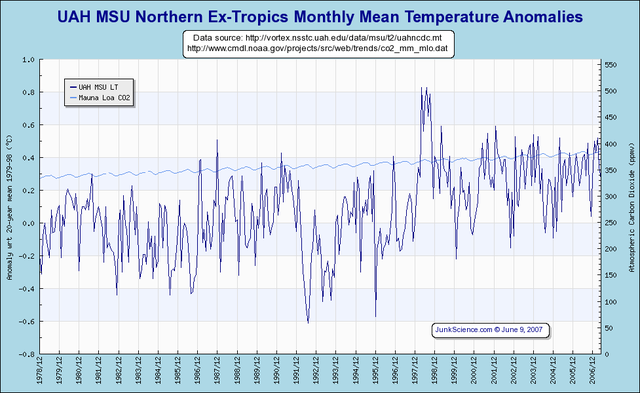Ross McKitrick has suggested a variation on a carbon tax that in effect challenges both Anthropogenic Global Warming (AGW) believers and skeptics to put their money where their mouth is. I, for one, would accept this challenge. He proposes a carbon tax on a sliding scale:
Suppose each country implements something called the T3 tax, whose U.S.
dollar rate is set equal to 20 times the three-year moving average of
the RSS and UAH estimates of the mean tropical tropospheric temperature
anomaly, assessed per tonne of carbon dioxide, updated annually. Based
on current data, the tax would be US$4.70 per ton, which is about the
median mainstream carbon-dioxide-damage estimate from a major survey
published in 2005 by economist Richard Tol.
He chooses the "tropical tropospheric temperature anomaly" because that is effectively the canary in the underground mine. According to AGW theory, the troposphere (the lowest 10km of atmosphere) will be warmed more than the earth's surface. McKitrick also says that AGW models show the tropics will be warmed more than high latitudes.
This tax rate is low, and would yield very little emissions
abatement. Global-warming skeptics and opponents of
greenhouse-abatement policy will like that. But would global-warming
activists? They should -- because according to them, the tax will climb
rapidly in the years ahead.
The IPCC predicts a warming rate in
the tropical troposphere of about double that at the surface, implying
about 0.2C to 1.2C per decade in the tropical troposphere under
greenhouse-forcing scenarios. That implies the tax will climb by $4 to
$24 per tonne per decade, a much more aggressive schedule of emission
fee increases than most current proposals. At the upper end of warming
forecasts, the tax could reach $200 per tonne of CO2 by 2100, forcing
major carbon-emission reductions and a global shift to non-carbon
energy sources.
Global-warming activists would like this. But so
would skeptics, because they believe the models are exaggerating the
warming forecasts. After all, the averaged UAH/ RSS tropical
troposphere series went up only about 0.08C over the past decade, and
has been going down since 2002. Some solar scientists even expect
pronounced cooling to begin in a decade. If they are right, the T3 tax
will fall below zero within two decades, turning into a subsidy for
carbon emissions.
At this point the global-warming alarmists would leap up to slam the
proposal. But not so fast, Mr. Gore: The tax would only become a carbon
subsidy if all the climate models are wrong, if greenhouse gases are
not warming the atmosphere, and if the sun actually controls the
climate. Alarmists sneeringly denounce such claims as "denialism," so
they can hardly reject the policy on the belief that they are true.
Under
the T3 tax, the regulator gets to call everyone's bluff at once,
without gambling in advance on who is right. If the tax goes up, it
ought to have. If it doesn't go up, it shouldn't have. Either way we
get a sensible outcome.
I think many skeptics would jump at such a proposal (as long as there is some control on AGW supporters "restating" and "correcting" the satellite readings -- there is nothing AGW scientists are better at than "correcting" historical numbers that don't fit their story line). One reason is that we skeptics know one of the AGW dirty little secrets: In fact, against all predictions of the theory, the troposphere has been warming less than the surface. Also, while I get conflicting inputs on whether the tropics or the northern latitudes should warm more, but if McKitrick is correct, the fact that the tropics have been warming less than higher norther latitudes (but more than southern latitudes) is also an inconsistency. In case you don't keep a full set of tropospheric temperature histories sitting on your desk, here are several from Global Warming at a Glance.
Warming for the lower troposphere in the tropics, note the 0.2C anomaly (click any image for larger version):

Here is the lower troposphere for the Northern Hemisphere above the tropics which is warming more than the tropics, with a 0.3 degree anomaly

And here is a comparison of Global lower troposphere temperatures (in blue) vs. one compilation by the GIS of measured surface temperatures in red. Note the divergence, which is exactly opposite of what AGW theory says has to happen, given the surface temps have a 0.5 to 0.6 degree anomaly Note that this may be because of some serious biases to ground based temperature measurement, but then that would mean that global warming is over-stated.

Look for my upcoming "Skeptical Layman's Primer to Anthropogenic Global Warming" or email me for a pre-release beta copy.







